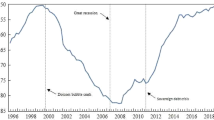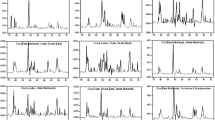Abstract
The statistical formulation of the econometric model is viewed as a sequence of marginalizing and conditioning operations which reduce the parametrization to managable dimensions. Such operations entail that the “error” is a derived rather than an autonomous process, suggesting designing the model to satisfy data-based and theory criteria. The relevant concepts are explained and applied to data modeling of UK new house prices in the framework of an economic theory-model of house builders. The econometric model is compared with univariate time-series models and tested against a range of alternatives.
Access this chapter
Tax calculation will be finalised at checkout
Purchases are for personal use only
Preview
Unable to display preview. Download preview PDF.
Similar content being viewed by others
Bibliography
Anderson, G. J. and Hendry, D. F. (1984). “An econometric model of United Kingdom building societies.” Oxford Bull. Econom. and Statist., 46, 185–210.
Atkinson, A. C. (1970). “A method for discriminating between models” (with discussion) J. Roy. Statist. Soc., Ser. B 32, 323–353.
Barndorff-Nielsen, O. (1978). Information and Exponential Families in Statistical Theory. New York: Wiley.
Bean, C. R. (1981). “An econometric model of manufacturing investment in the U. K.” Economic J. 91 106–121.
Box, G. E. P. and Jenkins, G. M. (1976). Time Series Analysis: Forecasting and Control revised ed. San Francisco: Holden-Day.
Box, G. E. P. and Pierce, D. A. (1970). “Distribution of residual autocorrelations in autoregressive-integrated moving average time series models.” J. Amer. Statist. Assoc. 65 1509–1526.
Chow, G. C. (1960). “Tests of equality between sets of coefficients in two linear regressions.” Econometrica 28 591–605.
Coen, P. G., Gomme, E. D., and Kendall, M. G. (1969). “Lagged relationships in economic forecasting” (with discussion) J. Roy. Statist. Soc., Ser. A, 132, No. 2, 133–163.
Cox, D. R. (1961). “Tests of separate families of hypotheses.” In J. Neyman (ed.), Proceedings of the Fourth Berkeley Symposium on Mathematical Statistics and Probability 1. Berkeley: Univ. of California Press, 105–123.
Cox, D. R. (1962). “Further results on tests of separate families of hypotheses.” J. Roy. Statist. Soc., Ser. B 24 406–424.
Dastoor, N. K. (1983). “Some aspects of testing non-nested hypotheses.” J. Econometrics 21 213–228.
Davidson, J. E. H., Hendry, D. F., Srba, F., and Yeo, S. (1978). “Econometric modelling of the aggregate time-series relationship between consumers’ expenditure and income in the United Kingdom.” Economic J. 88, 661–692.
Davidson, J. E. H. and Hendry, D. F. (1981). “Interpreting econometric evidence: the behaviour of consumers’ expenditure in the U. K.” European Economic Rev., 16, 177–198.
Domowitz, I. and White, H. (1982). “Misspecified models with dependent observations.” J. Econometrics, 20 35–58.
Engle, R. F. (1982). “Autoregressive conditional heteroscedasticity with estimates of the variance of United Kingdom inflations.” Econometrica, 50 987–1007.
Engle, R. F., Hendry, D. F., and Richard, J.-F. (1983). “Exogeneity.” Econometrica 51, No. 2, 277–304.
Ericsson, N. R. (1978). Modelling the Market for Owner-Occupied Housing in the United Kingdom: An Exercise in Econometric Analysis.M.Sc. Thesis. London School of Economics.
Florens, J.-P. and Mouchart, M. (1980). “Initial and sequential reduction of Bayesian experiments.” CORE discussion paper 8015. Louvain-la-Neuve, Belgium: Univ. Catholique de Louvain.
Godfrey, L. G. (1978). “Testing against general autoregressive and moving average error models when the regressors include lagged dependent variables.” Econometrica 46 1293–1301.
Granger, C. W. J. (1983). “Forecasting white noise” (with discussion). In A. Zellner (ed.), Applied Time Series Analysis of Economic Data. Washington: U.S. Bureau of the Census, 308–326.
Granger, C. W. J. and Newbold, P. (1977). “The time series approach to econometric model building.” In C. A. Sims (ed.), New Methods in Business Cycle Research. Minneapolis: Federal Reserve Bank of Minneapolis, 7–21.
Granger, C. W. J. and Weiss, A. A. (1983). “Time series analysis of error-correction models.” In S. Karlin, T. Amemiya, and L. A. Goodman (eds.), Studies in Econometrics, Time Series, and Multivariate Statistics. New York: Academic, 255–278.
Haavelmo, T. (1944). “The probability approach in econometrics.” Econometrica 12 suppl., i-viii, 1–118.
Harvey, A. C. (1981). The Econometric Analysis of Time Series. Oxford: Philip Allan.
Hendry, D. F. (1980). An Econometric Model of the UK Housing Market. London: Economists Advisory Group.
Hendry, D. F. (1984). “Econometric modelling of house prices in the United Kingdom.” In D. F. Hendry and K. F. Wallis (eds.), Econometrics and Quantitative Economics. Oxford: Basil Blackwell, Chapter 8, 211–252.
Hendry, D. F. and Anderson, G. J. (1977). “Testing dynamic specification in small simultaneous systems: An application to a model of building society behavior in the United Kingdom.” In M. D. Intriligator (ed.), Frontiers in Quantitative Economics Vol. IIIA. Amsterdam: North-Holland, Chapter 8c, 361–383.
Hendry, D. F., Pagan, A. R., and Sargan, J. D. (1984). “Dynamic specification.” In Z. Griliches and M. D. Intriligator (eds.), Handbook of Econometrics Vol. II. Amsterdam: North-Holland, Chapter 18, 1023–1100.
Hendry, D. F. and Richard, J.-F. (1982). “On the formulation of empirical models in dynamic econometrics.” J. Econometrics 20 3–33.
Hendry, D. F. and Richard, J.-F. (1983). “The econometric analysis of economic time series” (with discussion). Internat. Statist. Rev., 51, 111–163.
Jarque, C. M. and Bera, A. K. (1980). “Efficient tests for normality, homoscedasticity and serial independence of regression residuals.” Economics Lett. 6, 255–259.
Judge, G. G. and Bock, M. E. (1978). The Statistical Implications of Pre-test and Stein-Rule Estimators in Econometrics. Amsterdam: North-Holland.
Kiviet, J. F. (1981). “On the rigour of some specification tests for modelling dynamic relationships.” Paper presented at the Amsterdam Conference of the Econometric Society.
Kiviet, J. F. (1982). “Size, power and interdependence of tests in sequential procedures for modelling dynamic relationships.” Discussion paper, Univ. of Amsterdam.
Kmenta, J. and Ramsey, J. B. (eds.) (1981). Large-Scale Macro-econometric Models. Amsterdam: North-Holland.
Koopmans, T. C. (1950). “When is an equation system complete for statistical purposes?” In T. C. Koopmans (ed.), Statistical Inference in Dynamic Economic Models. Cowles Commission Monograph 10. New York: Wiley, Chapter 17, 393–409.
Lakatos, I. (1970). “Falsification and the methodology of scientific research programmes.” In I. Lakatos and A. Musgrave (eds.), Criticism and the Growth of Knowledge. Cambridge: Cambridge U. P., 91–195.
Mackinnon, J. G. (1983). “Model specification tests against non-nested alternatives” (with discussion). Econometric Rev. 2, 85–158.
Messer, K. and White, H. (1984). “A note on computing the heteroskedasticity-consistent covariance matrix using instrumental variables techniques.” Oxford Bull. Econom. and Statist. 46 181–184.
Mizon, G. E. (1984). “The encompassing approach in econometrics.” In D. F. Hendry and K. F. Wallis (eds.), Econometrics and Quantitative Economics. Oxford: Basil Blackwell, Chapter 6, 135–172.
Mizon, G. E. and Richard, J.-F. (1983). “The encompassing principle and its application to testing non-nested hypotheses.” CORE discussion paper 8330. Louvain-la-Neuve, Belgium: Univ. Catholique de Louvain, forthcoming, Econometrica.
Naylor, T. H., Seaks, T. G., and Wichern, D. W. (1972). “Box-Jenkins methods: an alternative to econometric models.” Internat. Statist. Rev. 40 123–137.
Nellis, J. G. and Longbottom, J. A. (1981). “An empirical analysis of the determination of house prices in the United Kingdom.” Urban Stud. 18 9–21.
Nelson, C. R. (1972). “The prediction performance of the FRB-MIT-PENN model of the U.S. economy.” Amer. Econom. Rev. 62, 902–917.
Pesaran, M. H. (1974). “On the general problem of model selection.” Rev. Econom. Stud. 41 153–171.
Prothero, D. L. and Wallis, K. F. (1976). “Modelling macroeconomic time series” (with discussion). J. Roy. Statist. Soc., Ser. A, 139, 468–500.
Rao, C. R. (1948). “Large sample tests of statistical hypotheses concerning several parameters with applications to problems of estimation.” Pro. Cambridge Philos. Soc.: Math, and Phys. Sci. 44 50–57.
Schumpeter, J. (1933). “The common sense of econometrics.” Econometrica 1, 5–12.
Schwarz, G. (1978). “Estimating the dimension of a model.” Ann. Statist. 6, 461–464.
Smith, A. (1982). A Mathematical Introduction to Economics. Oxford: Basil Blackwell.
Theil, H. (1964). Optimal Decision Rules for Government and Industry. Amsterdam: North-Holland.
Trivedi, P. K. (1984). “Uncertain prior information and distributed lag analysis.” In D. F. Hendry and K. F. Wallis (eds.), Econometrics and Quantitative Economics. Oxford: Basil Blackwell, Chapter 7, 173–210.
White, H. (1980). “A heteroskedasticity-consistent covariance matrix estimator and a direct test for heteroskedasticity.” Econometrica, 48 No. 4, 817–838.
Zellner, A. and Palm, F. (1974). “Time series analysis and simultaneous equation econometric models.” J. Econometrics, 2 17–54.
Editor information
Editors and Affiliations
Rights and permissions
Copyright information
© 1985 Springer-Verlag New York Inc.
About this paper
Cite this paper
Ericsson, N.R., Hendry, D.F. (1985). Conditional Econometric Modeling: An Application to New House Prices in the United Kingdom. In: Atkinson, A.C., Fienberg, S.E. (eds) A Celebration of Statistics. Springer, New York, NY. https://doi.org/10.1007/978-1-4613-8560-8_11
Download citation
DOI: https://doi.org/10.1007/978-1-4613-8560-8_11
Publisher Name: Springer, New York, NY
Print ISBN: 978-1-4613-8562-2
Online ISBN: 978-1-4613-8560-8
eBook Packages: Springer Book Archive




